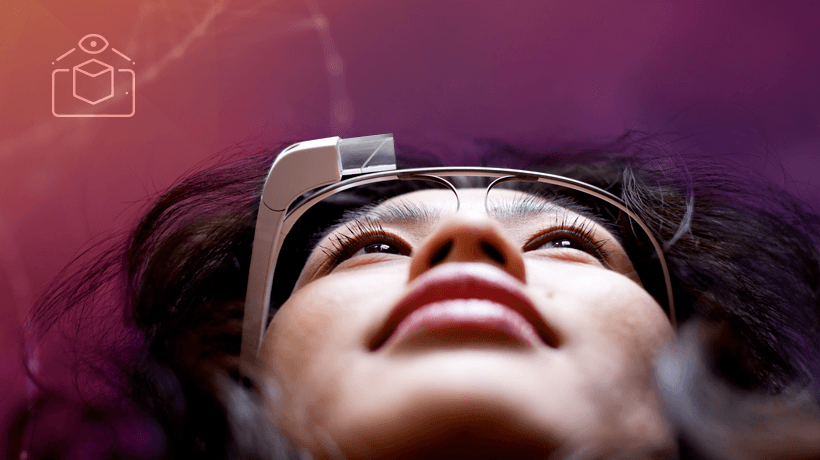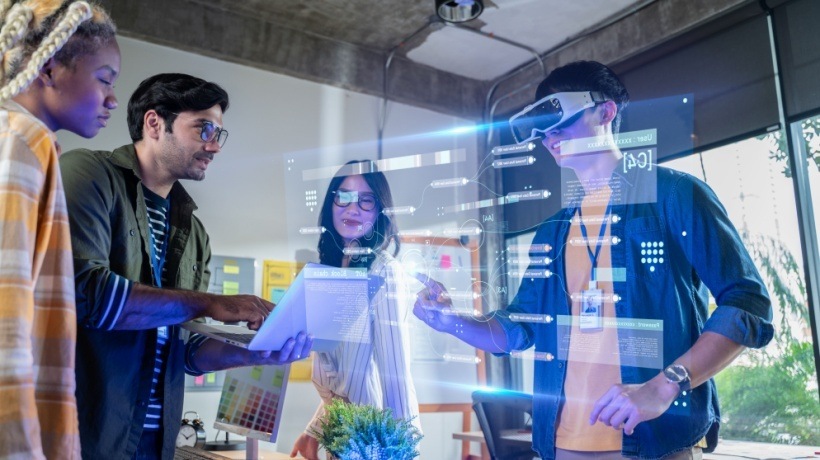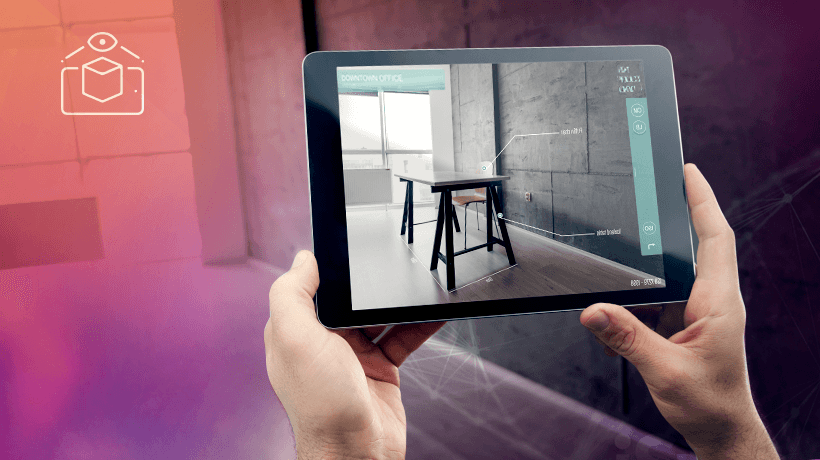Why AR Training Is Improving Learning And Development
Do a quick web search, and you will find dozens of articles predicting how Augmented Reality (AR) is going to revolutionize the way we consume media. There’s a good reason for all the buzz, as the numbers show: According to Statista, the global market size for AR went from $6.1 billion in 2016 to $27 billion in 2018. Statista also forecasts a huge jump over the next four years, up to a whopping $209.2 billion in 2022 [1]. As technology becomes more cost-effective and accessible to a mainstream audience, it’s also becoming a trend in Learning and Development (L&D), paving the way for more dynamic learning opportunities. "As Apple and Android make their phones ready for AR and bring the technology to the mainstream, developing learning programs becomes far more accessible," says Adrian Soto, Director of Future Technologies at SweetRush SPARK.

Let's take a look at 4 reasons why AR training is improving L&D:
1. AR Enables A Social Learning Experience
In previous articles, I explained that AR superimposes a digital image over the real world, and elevates the experience by showing real-time information about the objects the learner is looking at. In comparison to Virtual Reality (VR), Dan White, CEO of Filament Games [2], says "AR views the physical world as an asset," in contrast to VR, a technology to which the real world is a distraction. That key difference between these two technologies makes AR training a better option for social learning, a learning methodology in which people learn from one another, through observation, imitation, and modeling. "From a social learning perspective, knowledge is constructed while individuals are engaging in activities, receiving feedback, and participating in other forms of human interaction in public, social contexts," wrote Janette R. Hill for the American Journal of Distance Education [3]. When it comes to applying emerging technologies to L&D, AR training offers a distinct advantage over other modalities, such as VR. "VR is inherently a very siloed experience: You put on a headset, you can’t see other people, you can’t hear them or interact with them. It’s very difficult to get a group of people involved with VR," says Justin Mitchell, Creative Engineer at SweetRush. AR does the opposite, allowing a far more social experience. "It’s very easy to just get an iPad and let a group of people crowd around it and share the same learning experience through the use of AR," adds Mitchell.
2. AR Captivates Audiences, Which Increases Engagement
There’s a quote by John Cleave, Ph.D., an eLearning Technologist at SweetRush, that perfectly illustrates what learning is all about: "Learning as a journey goes beyond pushing out a linear sequence of modules. It means creating a tapestry of experiences: training modules, curation, social media and feedback, events, and continuous data analytics to understand where people are at and where they would like to go." He adds, "Learning is a process that happens over time through formal, informal, and self-perpetuated means." For learning to be effective, it needs to capture and keep the attention of learners during this learning journey. While we can make the case that all emerging technologies are effective in this regard, AR tops the list because it can engage larger audiences simultaneously and socially (as previously explained under #1 above). "AR elevates learning when the existing methods of presenting information are not captivating audiences the way they should be," says Justin Mitchell. "When people are dropping out of a course, or they’re not excited about their training material, or they simply don’t go back to the information, AR can help by making people more involved and more excited not only to learn but to share the experience with others."
3. AR Facilitates Data And Concept Visualization
Imagine a group within a company that's in charge of doing field research and obtaining data from clients. Although the group lives and breathes data, they need to present the numbers to someone else – maybe a CEO, maybe someone in the HR department – who’s not as savvy with numbers. Normally, the research group would send a PDF or a presentation with graphics; both of these options run the risk of being flat and boring, even hard to understand. With AR, they could tell a story about that data, getting their audience excited about it. For instance, they could ask the audience to use their phones to scan a symbol in a plain document, which would then display a digital image that highlights the results of the research, along with additional information, in real time. Through AR, data visualization can become an experience that the audience can share with others, which makes it more engaging. As Mitchell explained in a previous article, with AR training you can get information in real time, elevating the learning experience. "Imagine placing your phone on top of a textbook, and whenever there’s a new term you need to learn, a video pops up to explain it to you," he said. "By overlaying digitized information onto real-world situations, AR can help explain abstract concepts by linking tangible real-life environments," writes Judy Bloxham, eLearning Advisor. [4] "This is particularly useful when learners don’t have the first-hand experience; it’s the next best thing to the real experience."
4. AR Encourages A Practical Approach And Point-Of-Need Learning
In an article published by the Harvard Business Review [5], authors Magid Abraham and Marco Annunziata describe an example of AR training currently being used in manufacturing and industrial settings. They describe an assembly plant and warehouse in which workers use smart glasses that overlay computer-generated video, graphic, or text information onto physical objects – for example, step-by-step repair instructions hovering over a machine part, visually guiding a worker through the job. "These technologies," the authors explain, "increase productivity by making workers more skilled and efficient, and thus have the potential to yield both more economic growth and better jobs." AR training allows a one-of-a-kind approach to point-of-need learning, as the previous example shows. Through the use of the technology, paired with wearable devices, learners can receive the exact information they need to perform a task at hand. "You want AR because you want your learners to have access to relevant content anywhere they are, not just in the classroom or at their desk," adds Bloxham. The point-of-need approach goes hand-in-hand with relevance. This is another strong feature of AR training. Concepts that are hard to grasp and apply to day-to-day jobs can be far easier to understand when presented with AR. In an AR-assisted course, learners are moving around, exploring their real-world environment or performing a task, and receiving information in real time. "This helps learners to appreciate the importance of concepts and ideas instead of merely brushing them off as a theoretical knowledge that has no correlation with their work duties or responsibilities," writes Christopher Pappas.
***
These are but a few reasons why AR training is improving L&D. The technology is in constant evolution, and that means more reasons will continue to emerge. This may be a little cliché, but it’s true: When it comes to AR training, the possibilities are truly endless. For more on what AR has to offer for L&D, keep an eye on the SPARK team at SweetRush.
Download the eBook Top Emerging Technology Trends And Their Impact On L&D to see how the emergence of virtual reality and augmented reality can open up new ways of working for L&D professionals. Learn why they are new powerful tools in teaching and affecting behavioral change and how they can help you achieve your business objectives.
If you want to discover more fantastic features you need to implement Virtual Reality in your organization, check out the webinar Virtual Reality: Real-World Hilton/SweetRush Project Case Studies. It is brought to you by SweetRush and teaches everything you need to know to run an exceptional VR learning program.
References:
- Forecast augmented (AR) and virtual reality (VR) market size worldwide from 2016 to 2022 (in billion U.S. dollars)
- Augmented Reality: The Future of Job Training
- Social Learning Theory and Web-Based Learning Environments: A Review of Research and Discussion of Implications
- Augmented reality learning
- Social Learning Theory and Web-Based Learning Environments: A Review of Research and Discussion of Implications










